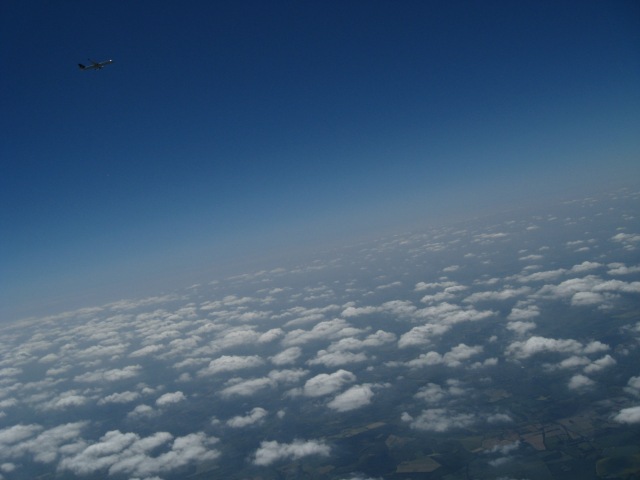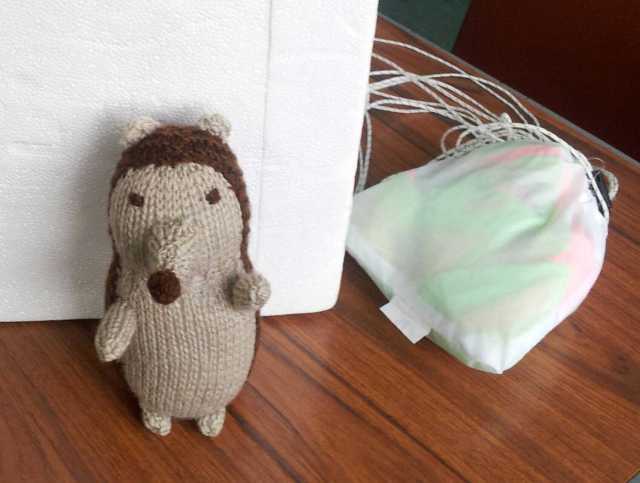Welcome to the first article about Horizon’s new mission, ‘Beat Felix!’ Horizon is the near space programme at Queen Mary’s Grammar School, Walsall. We are a team of pupils who build and launch autonomous probes into the region of the atmosphere known as ‘near space’ (20-100km above the Earth’s surface).
 Photo of the Isle of Wight taken at 32000m by the Go Pro Hero 2 onboard Horizon 2
Photo of the Isle of Wight taken at 32000m by the Go Pro Hero 2 onboard Horizon 2
Last year’s team launched the first two Horizon probes, carried the UK’s Space Mascot ‘CASSiE’ on her first high altitude flight (more about her later!), set the 44th Highest World Amateur Altitude and brought back footage of the journey through the blue, familiar Troposphere and out into the cold black void of the Stratosphere.
Inspired by last year’s ‘Near Space Jump’ we plan to beat the altitude achieved by Felix Baumgartner and the Red Bull Stratos Team and go after a top ten position in the Amateur World Altitude Records. Roy Fisher and the team at Proto-pic.co.uk have generously offered their support for our programme’s goals and we’re really looking forward to working with them to bring you the inside story on the project and its progress.
HOW WILL WE DO IT?
We have three launches planned this year; early May, late June and early July. The first launch will be a training mission as we find our feet. Our first launch will be ‘Horizon 3’ (a working title until we come up with a better name for it), a light weight, energy efficient version of last year’s probe.
 Horizon 1 ready for launch – From left to right: The payload box, pre-deployed parachute and weather balloon
Horizon 1 ready for launch – From left to right: The payload box, pre-deployed parachute and weather balloon
The probe will be carried under a pre-deployed parachute which will be attached to a helium filled weather balloon. It will contain:
– a flight computer which will transmit the probe’s location back to Earth using a radio signal;
– a sensor array which will record temperature inside and outside of the probe, relative humidity and atmospheric pressure;
– a back-up tracker in the form of a small smartphone which can be commanded to send its exact location back by text message;
– a GoPro Hero 2 video camera to capture in-flight footage.
By visiting our webpage you’ll be able to track the probe’s location throughout the flight and hopefully watch the launch live on ‘Horizon TV’.

The first Flight Computer built by the Horizon Team undergoing testing
Horizon 4 and 5 (again, working titles) are out record attempts and will launch in June and July. These probes will be even lighter than Horizon 3, weighing just a couple of hundred grams. They will be attached to Hydrogen filled weather balloons. Hydrogen provides greater lift than Helium but is more volatile and so we have the gas experts from BOC Gases UK helping us design new filling equipment and write new safety procedures. The probes will carry a light-weight flight computer so that we can track them throughout their flight. They should achieve an even greater altitude than Horizon 3 but we will probably have to travel much further to retrieve them.
WHAT IS ‘NEAR SPACE’?
The Earth’s atmosphere is made up of several distinct layers. The first layer is the Troposphere. This is our blue breathable atmosphere; it contains most of the world’s moisture and varies in thickness from 10km at the poles to 17km at the equator. Commercial aircraft fly in this region at between 9 and 12km in altitude.
 Photograph of a plane over West Berkshire, taken by the automated camera on Horizon 2.
Photograph of a plane over West Berkshire, taken by the automated camera on Horizon 2.
The Troposphere transitions into the Stratosphere which is black, very thin (almost negligible pressure) and has a background of cosmic radiation level approximately a hundred times that at sea level. The Stratosphere runs from the top of the Troposphere to 50km above sea level and contains the Ozone Layer which prevents an intense flux of ultraviolet radiation from reaching the surface of Earth.
WHAT IS PROJECT HORIZON?
Project Horizon was founded in February 2012 by a mathematics teacher at Queen Mary’s Grammar School, Walsall. He originally intended to recruit a small team to build an autonomous probe and fly it into the Stratosphere using a weather balloon filled with Helium. The pupils’ response to the project was overwhelming and it quickly became clear that the project could have much greater scope. Instead of just one launch he decided to set up a near space program capable of carrying out launches every year. Pupils were recruited into four teams:
– Publicity and Sponsorship
– General Engineering and Radio
– Electrical Engineering
– ICT and Media
 The Horizon Team preparing for the launch of Horizon 1
The Horizon Team preparing for the launch of Horizon 1
The four teams worked together to plan, design and build the different aspects of the project. The pupils also setup a live online video feed for launch days dubbed ‘Horizon TV’. A bigger project required wider goals and Horizon now aims to:
– develop a reusable launch platform that could make regular trips into the Stratosphere (30-40km above the Earth’s Surface and far beyond the safe blue breathable atmosphere).
– provide a rich STEM (Science, Technology, Engineering and Mathematics) activity at the school which was accessible to the pupils and ran on a shoe-string budget.
– inspire pupils at the school to take an early interest in Space science, the UK Space Industry , STEM subjects and activities.
– forge links between the school and engineering/technology firms in order to broaden the pupils’ aspirations and discover exciting new opportunities for them.
A fresh team are recruited and trained each year and each team has their own mission and adds their own touch to the programme. Horizon also enjoys the support of the UK’s Space Mascot ‘CASSiE’ and her creator Vix Southgate.
 CASSIE- The UK Space Mascot (mini version)
CASSIE- The UK Space Mascot (mini version)
To find out more about CASSiE and her adventures please head over to her blog (http://spacemascotuk.wordpress.com) or her facebook page (https://www.facebook.com/SpaceMascotUK)
We hope this initial article has piqued your interest. To learn more about the project’s past, head on over to our website (http://horizon.qmgs.walsall.sch.uk). We’ll be writing more articles for the proto-pic.co.uk blog as the project develops and you can get the very latest news from the project’s twitter feed (https://twitter.com/horizonqmgs).


I believe this should be ‘Beat Babbage’, who’s already beat Felix: http://www.daveakerman.com/?p=1362
Only just though! Good luck 🙂